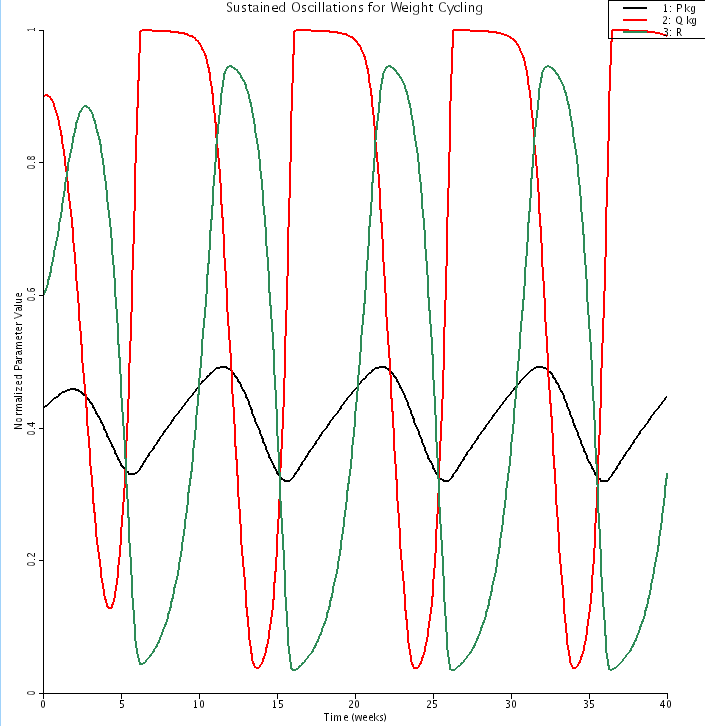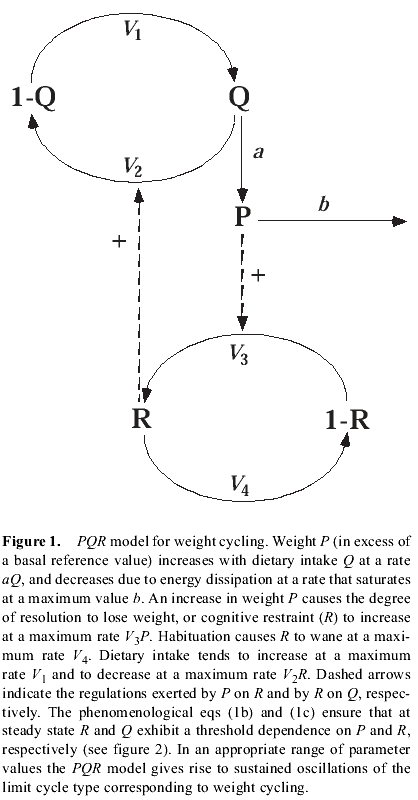A model for the dynamics of human weight cycling based on the work of Albert Goldbeter [J. Biosci, 31, 129-136] and presented by Lauren Shepherd as a final project for BIOEN 589, University of Washington.
Description
The resolution to lose weight by cognitive restraint of nutritional intake often leads to repeated bouts of weight loss and regain, a phenomenon known as weight cycling or “yo-yo dieting.” A simple mathematical model for weight cycling is presented. The model is based on a feedback of psychological nature by which a subject decides to reduce dietary intake once a threshold is exceeded. The analysis of the model indicates that sustained oscillations in body weight occur in a parameter range bounded by critical values. Only outside this range can body weight reach a stable steady state. The model provides a theoretical framework that captures key facets of weight cycling and suggests ways to control the phenomenon. The view that weight cycling represents self-sustained oscillations has indeed specific implications. In dynamical terms, to bring weight cycling to an end, parameter values should change in such a way as to induce the transition of body weight from sustained oscillations around an unstable steady state to a stable steady state. Maintaining weight under a critical value should prevent weight cycling and allow body weight to stabilize below the oscillatory range. The original model was changed by Lauren Shepherd to allow exploration of the effects of metabolic changes over time. The static parameter 'a' (metabolic efficiency) was turned into a linear function that slowly increases with time. To activate this part of the code, enter '2' as the value for the 'ab' parameter. Under these conditions, the oscillatory behavior still exists, but the maximum body weight continues to climb over time. A second change can be made by altering the energy dissipation parameter 'b'. To activate this change, enter '3' as the value for the 'ab' parameter. A body weight decrease will be observed with this metabolic change.


Equations
Calculation of the Threshold Values:


ODE System:



The equations for this model may be viewed by running the JSim model applet and clicking on the Source tab at the bottom left of JSim's Run Time graphical user interface. The equations are written in JSim's Mathematical Modeling Language (MML). See the Introduction to MML and the MML Reference Manual. Additional documentation for MML can be found by using the search option at the Physiome home page.
- Download JSim model MML code (text):
- Download translated SBML version of model (if available):
We welcome comments and feedback for this model. Please use the button below to send comments:
Goldbeter, A., A model for the dynamics of human weight cycling, 2006, J. Biosci, 31, 129-136.
Please cite https://www.imagwiki.nibib.nih.gov/physiome in any publication for which this software is used and send one reprint to the address given below:
The National Simulation Resource, Director J. B. Bassingthwaighte, Department of Bioengineering, University of Washington, Seattle WA 98195-5061.
Model development and archiving support at https://www.imagwiki.nibib.nih.gov/physiome provided by the following grants: NIH U01HL122199 Analyzing the Cardiac Power Grid, 09/15/2015 - 05/31/2020, NIH/NIBIB BE08407 Software Integration, JSim and SBW 6/1/09-5/31/13; NIH/NHLBI T15 HL88516-01 Modeling for Heart, Lung and Blood: From Cell to Organ, 4/1/07-3/31/11; NSF BES-0506477 Adaptive Multi-Scale Model Simulation, 8/15/05-7/31/08; NIH/NHLBI R01 HL073598 Core 3: 3D Imaging and Computer Modeling of the Respiratory Tract, 9/1/04-8/31/09; as well as prior support from NIH/NCRR P41 RR01243 Simulation Resource in Circulatory Mass Transport and Exchange, 12/1/1980-11/30/01 and NIH/NIBIB R01 EB001973 JSim: A Simulation Analysis Platform, 3/1/02-2/28/07.

